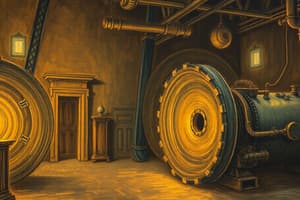Podcast
Questions and Answers
What is a generator?
What is a generator?
An electrical generator is a machine that converts mechanical energy into electrical energy.
Explain briefly the general principles of a DC Generator.
Explain briefly the general principles of a DC Generator.
A DC Generator converts mechanical energy into electrical energy using a stationary magnetic field and a rotating coil to induce current.
What determines the magnitude of the induced current in a DC Generator?
What determines the magnitude of the induced current in a DC Generator?
The magnitude of the induced current depends on the strength of the magnetic field, the length of the coil, and the speed of the coil's movement.
The direction of induced current does not change when the direction of motion of the conductor changes.
The direction of induced current does not change when the direction of motion of the conductor changes.
What is the function of a split ring commutator in a DC Generator?
What is the function of a split ring commutator in a DC Generator?
Who discovered the scientific principle on which generators operate?
Who discovered the scientific principle on which generators operate?
What are the two basic essential parts of an electrical generator?
What are the two basic essential parts of an electrical generator?
Flashcards are hidden until you start studying
Study Notes
Direct Current Generator Principles
- A Direct Current (DC) generator converts mechanical energy into electrical energy.
- The energy conversion principle relies on dynamically induced electromotive force (e.m.f.).
- When a conductor cuts magnetic flux, an e.m.f. is produced, as per Faraday's Laws of Electromagnetic Induction.
- A closed conductor circuit allows the induced e.m.f. to drive a current.
- Key components of a DC generator include a magnetic field and conductors that move to intersect the flux.
Principle of Operation
- Generators operate based on the principle discovered by Michael Faraday and Joseph Henry in 1831.
- A rotating coil within a magnetic field induces a current in the coil, measurable by a galvanometer.
- The induced current's strength depends on the magnetic field's strength, the coil's length, and the rotation speed.
- Both rotating the coil within a stationary magnetic field or rotating the magnetic field around a stationary coil result in current induction.
- Most DC generators have a stationary magnetic field and a rotating coil, while AC generators have a stationary coil and a rotating magnetic field.
- Faraday's laws state that an e.m.f. is induced when a conductor is placed in a varying magnetic field or moved within a magnetic field.
- The induced e.m.f. can be calculated using a specific DC generator formula.
- A closed path for the conductor enables the induced current to circulate.
- In a DC generator, field coils generate the magnetic field, and the armature conductors rotate within it.
- The rotation induces an e.m.f. in the armature conductors.
- Fleming's Right Hand Rule determines the direction of the induced current, reversing with the conductor's motion direction.
- A split ring commutator reverses the armature conductor connections when current reversal occurs, leading to unidirectional current output.
Simple Loop Generator
- A single-turn rectangular copper coil (ABCD) rotating on its axis within a magnetic field (from permanent or electromagnets) is a simple DC generator model.
- The coil's ends are connected to two slip rings, which rotate with the coil.
- Two stationary brushes press against the slip rings, collecting the induced current.
- The coil's rotation in the magnetic field generates an alternating current within the coil.
- The slip rings and brushes contribute to extracting the current from the rotating coil.
- The current flowing through the external circuit is unidirectional, due to the commutator's switching action.
- This simple loop generator demonstrates the fundamental principles of DC generator operation – magnetic field, rotating conductor, and commutator for unidirectional output.
Studying That Suits You
Use AI to generate personalized quizzes and flashcards to suit your learning preferences.




